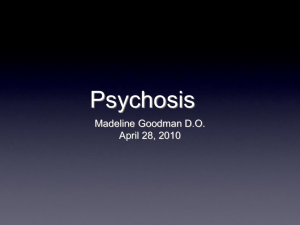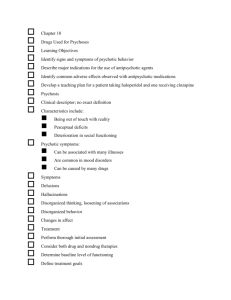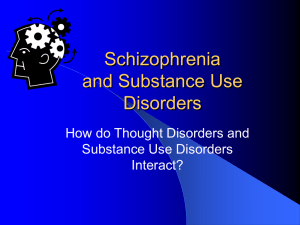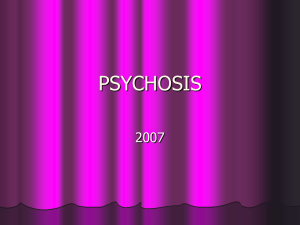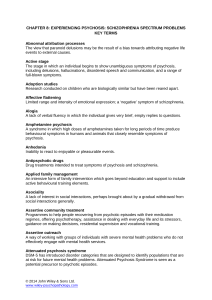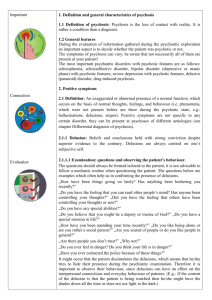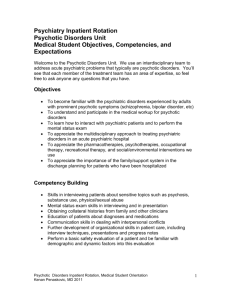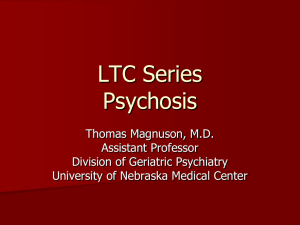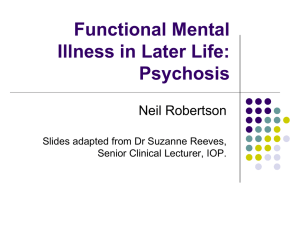Connection Important Important Important Connection Important
advertisement
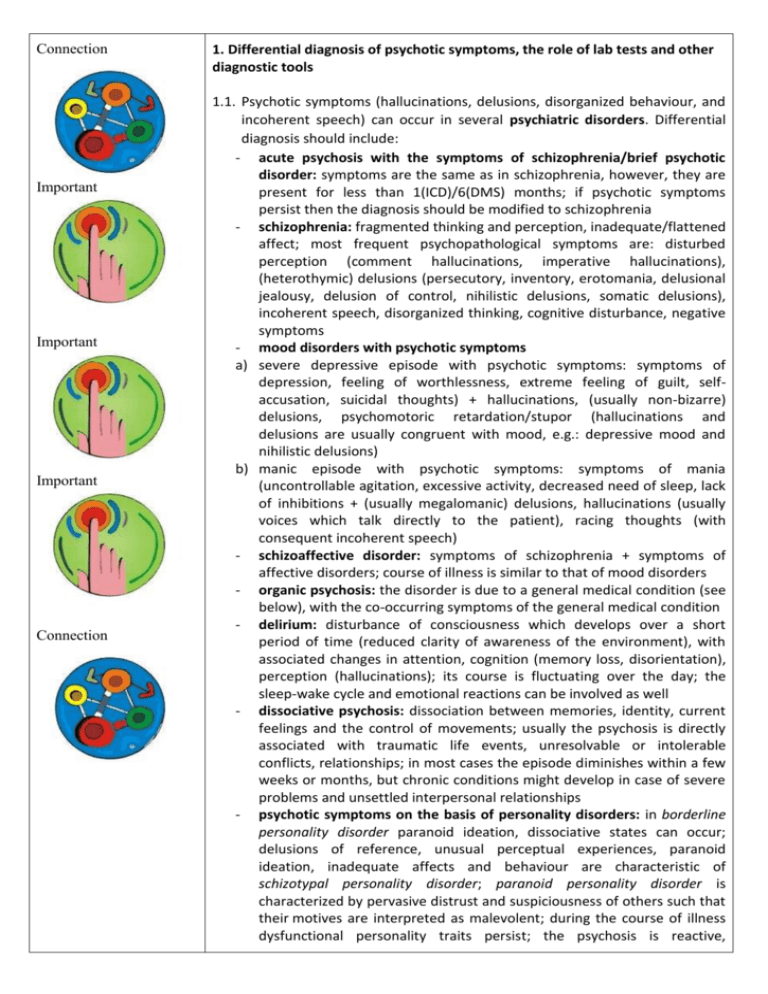
Connection Important Important Important Connection 1. Differential diagnosis of psychotic symptoms, the role of lab tests and other diagnostic tools 1.1. Psychotic symptoms (hallucinations, delusions, disorganized behaviour, and incoherent speech) can occur in several psychiatric disorders. Differential diagnosis should include: - acute psychosis with the symptoms of schizophrenia/brief psychotic disorder: symptoms are the same as in schizophrenia, however, they are present for less than 1(ICD)/6(DMS) months; if psychotic symptoms persist then the diagnosis should be modified to schizophrenia - schizophrenia: fragmented thinking and perception, inadequate/flattened affect; most frequent psychopathological symptoms are: disturbed perception (comment hallucinations, imperative hallucinations), (heterothymic) delusions (persecutory, inventory, erotomania, delusional jealousy, delusion of control, nihilistic delusions, somatic delusions), incoherent speech, disorganized thinking, cognitive disturbance, negative symptoms - mood disorders with psychotic symptoms a) severe depressive episode with psychotic symptoms: symptoms of depression, feeling of worthlessness, extreme feeling of guilt, selfaccusation, suicidal thoughts) + hallucinations, (usually non-bizarre) delusions, psychomotoric retardation/stupor (hallucinations and delusions are usually congruent with mood, e.g.: depressive mood and nihilistic delusions) b) manic episode with psychotic symptoms: symptoms of mania (uncontrollable agitation, excessive activity, decreased need of sleep, lack of inhibitions + (usually megalomanic) delusions, hallucinations (usually voices which talk directly to the patient), racing thoughts (with consequent incoherent speech) - schizoaffective disorder: symptoms of schizophrenia + symptoms of affective disorders; course of illness is similar to that of mood disorders - organic psychosis: the disorder is due to a general medical condition (see below), with the co-occurring symptoms of the general medical condition - delirium: disturbance of consciousness which develops over a short period of time (reduced clarity of awareness of the environment), with associated changes in attention, cognition (memory loss, disorientation), perception (hallucinations); its course is fluctuating over the day; the sleep-wake cycle and emotional reactions can be involved as well - dissociative psychosis: dissociation between memories, identity, current feelings and the control of movements; usually the psychosis is directly associated with traumatic life events, unresolvable or intolerable conflicts, relationships; in most cases the episode diminishes within a few weeks or months, but chronic conditions might develop in case of severe problems and unsettled interpersonal relationships - psychotic symptoms on the basis of personality disorders: in borderline personality disorder paranoid ideation, dissociative states can occur; delusions of reference, unusual perceptual experiences, paranoid ideation, inadequate affects and behaviour are characteristic of schizotypal personality disorder; paranoid personality disorder is characterized by pervasive distrust and suspiciousness of others such that their motives are interpreted as malevolent; during the course of illness dysfunctional personality traits persist; the psychosis is reactive, Important, Connection - - Important temporary; course of illness is not episodic, unlike in schizophrenia psychosis due to the use of psychoactive substances: psychotic symptoms developing during/after the use of substance use; symptoms cannot be better explained by acute intoxication or withdrawal; hallucinations are mainly auditory, but can occur in other modalities as well; delusions are often persecutory; psychomotorium is agitated, but stupor can develop as well; affects are augmented from intense fear to ecstasy; symptoms are less detailed compared to schizophrenia; cooccurring vegetative signs can be significant postpartum psychosis: psychotic condition developing around pregnancy/childbirth, see below delusional disorder (paranoid disorder): its main symptom is the presence of non-bizarre („could-be-true”) delusions; perceptual disturbances are not present/only present in the form of elemental hallucinations; due to the delusions secondary symptoms (such as anxiety, insomnia, etc.) can occur; there is usually no general disturbance of everyday functioning; negative and cognitive symptoms are not present 1.2. Psychotic symptoms can not only develop in case of psychiatric disorders, as a general rule, their differential diagnosis should always include the consideration of (at least) the following general medical conditions: - CNS disorders: tumours, epilepsy, meningitis, encephalitis, multiple sclerosis, autoimmune disorders (e.g.: antiNMDA-receptor encephalitis) - endocrine disorders: hypo- or hyperthyreosis, Addison’s disease, Cushing’s disease, hypo- or hyperparathyreoidism - metabolic changes: renal failure, hypo- or hyperglycaemia, porphyria, haemochromatosis, Wilson’s disease, paraneoplasia - haematologic conditions: leukemia, funicular myelosis - infectious diseases: HIV, syphilis, neuroborreliosis - toxic effects: drugs, medications (pl.: dopaminergic antiparkinson-agents, steroids) 1.3. In order to rule out the above mentioned conditions the following methods can be used: cranial CT/MRI, lab tests (blood count, renal function tests, liver tests, electrolytes, inflammatory markers, drug tests, blood sugar test, urine tests, hormone and drug level monitoring), EEG, liquor sample analysis, antibody titre determination. Important 2. Types, indications, mechanism of action and side effects of antipsychotic agents 2.1. Acute psychotic episodes are treated with antipsychotic agents. Since due to their condition patients don’t or reluctantly take medication, most of the antipsychotics are also available in the form of oral solutions or injections as well. In the acute treatment of psychosis the following agents are often administered: olanzapine (orodispersible tablet, tablet, injection), risperidone (oral solution, tablet), haloperidol (injection, oral solution, tablet), aripiprazole (tablet, injection). It is important to note that antipsychotic treatment should be supplemented with anxiolytics, benzodiazepines (e.g.: clonazepame, available both as a tablet and as an injection). When benzodiazepines are administered their side effect of respiratory depression needs to be minded! During the pharmacological treatment of schizophrenia carers often meet patients with partially or non-compliant patients. In such cases so-called depot injections can be considered, which need to be administered every 2/3/4 weeks, depending on the agent and the dose (e.g.: olanzapine, risperidone, paliperidone, aripiprazole, haloperidol, zuclopenthixol). 2.2. In the everyday clinical practice antipsychotics can be divided into first- and second generation agents, or with other words typical/atypical antipsychotics. During the administration of typical antipsychotics the biggest concern is caused by the so-called extrapyramidal side-effects. Their occurrence can be lowered with gradual initiation and discontinuation of antipsychotic treatment. Important Important Important 2.3. List and treatment of extrapyramidal side-effects: acute dystonia - involuntary muscle contractions of the muscles of the head/neck/tongue - treatment: biperiden(tablets or injection)/procyclidine(tablets), lowering the dose of antipsychotics akathisia - feeling of inner restlessness and a compelling need to be in constant motion - treatment: beta-blockers, benzodiazepines, lowering the dose of antipsychotics parkinsonism - bradykinesia, rigor, tremor - treatment: lowering the dose of antipsychotics, change of antipsychotic agent (to an atypical antipsychotic) tardive dyskinesia - involuntary, repetitive movements of the facial and perioral muscles, choreiform movements - treatment: late side effect, unrelated to the dose of antipsychotics, therefore its treatment is challenging; it is important to note that the discontinuation of antipsychotic agents can worsen the symptoms, therefore a change to e.g. clozapine should be considered neuroleptic malignant syndrome (NMS) - potentially life-threatening, severe side effect (mortality of 20%!) - symptoms: severe muscle rigidity, hyperthermia, instable autonomous functions (tension, pulse, dyspnoea, hyperventilation, hyperhidrosis), altered consciousness, elevated creatine kinase level, leucocytosis, myoglobinuria, renal failure - treatment: immediate cessation of antipsychotic treatment, lowering the body temperature, treatment of volume depletion, monitoring, supported breathing/circulation, possibly amantadine/dantrolene/bromocriptine - treatment should take place at an intensive care unit 2.4. Other side effects: orthostatic hypotension dry mouth sexual dysfunction tachycardia conduction disorders (prolonged QT interval, which might lead to cardiac arrhythmias) obstipation difficulty urinating acute attacks of glaucoma agranulocytosis (clozapine) galactorrhea decreased seizure threshold (epileptic seizures, most frequently in case of clozapine treatment) 2.5. Among the most frequent side effects of second generation antipsychotics metabolic syndrome (weight gain, insulin resistance, dyslipidaemia) and their sedative effect should be mentioned. It is important to underline that since different agents with different receptor profile belong to the group of atypical antipsychotics, side effects of certain second generation antipsychotics can differ from each other. Another important fact is that extrapyramidal symptoms can also occur when using second generation agents, but generally less frequently/in a less severe form than in case of FGAs. Important 3. Rehabilitation of people with psychotic illness, the approach of community psychiatry The treatment of psychotic disorders does not end with hospitalization or with pharmacotherapy; rehabilitation is an important step as well. Rehabilitation aims to regain pre-illness functionality. The rehabilitation of psychiatric patients can happen within the hospital or in the patient’s home, within the community. Community mental health services support the patient in a domiciliary setting. Services are provided by a team, which involves social workers, psychologists, psychiatrists, mental health workers. This team, led by a case manager, visits the patient regularly, helping him/her in not only solving medical issues, but also providing support regarding financial and intrafamilial problems. The method proved to be effective in the long-term care of schizophrenia patients. During community care patients can take part in different trainings aiming to improve their abilities. Since a great number of patients with schizophrenia are unable to work in a competitive environment, working at so-called protective workplaces can be an important step in their rehabilitation. Work experience within these protective workplaces can unfortunately not be generalized, therefore, supported employment might be a useful step, where patients are helped in the acquirement of necessary abilities and individual support is provided. 4. Psychotherapy of psychotic disorders Individual and group (family) psychoeducation plays a key role in the psychotherapy of psychotic disorders. During psychoeducation the symptoms, course of illness, aetiology of the disorder are discussed in a detailed an understandable manner. It is important to mention the different treatment possibilities, to talk about substance (alcohol and drug) misuse, to promote healthy lifestyle and to teach to notice the so-called early alarming symptoms (such as insomnia or strengthened hallucinations, etc.). With their recognition psychotic relapses can be avoided or noticed early. Further psychotherapeutic interventions, such as CBT (cognitive behaviour therapy), family therapy/intervention, social trainings (assertive communication, skill trainings, problem-solving trainings) and psychodynamic psychotherapy can successfully be used in the psychotherapeutic treatment of psychosis. It is important to note, however, that psychotherapeutic approaches are treatment options used with pharmacological treatments, in remission only. 5. Puerperal psychiatric conditions and their treatment Task 5. 1. Case report 26-year-old woman without previous psychiatric history arrives to the hospital with the help of the police, with an ambulance car. The patient gave birth to her first child three weeks ago. Upon arrival, the patient holds her baby in her hands. Her husband, who arrived with his wife, tells us that her wife wanted to jump off the balcony, which he noticed and prevented. His wife has been acting weirdly recently: often she was just staring blankly, murmuring something, with the baby in her hands. She has not been sleeping since days, and it occurred many times that she has been “distant”, not noticing that she has been talked to. She is also very worrisome, does not give the baby away ever since she was born, she is sitting by her side, watching her. Her husband received a job abroad, he will soon need to travel to work. Upon examination the patient denies having suicidal thoughts. Her speech is fast, and she keeps looking at her baby. She believes that she is worthless, and also admits that see feels that someone might harm the baby, that is why she does not want to part from her. Task 5. 2. Questions Which psychopathological symptoms are present in the case report? What might be the diagnosis of the patient? Which other psychiatric illnesses can occur also in the peripartum period? What sort of treatment do you recommend? Important 5. 3. Postpartum psychosis Psychotic episode which develops after childbirth. Its occurrence is around 1/1000 births; it usually develops within the first month after childbirth. Postpartum psychosis usually develops very suddenly. Besides psychotic symptoms affective symptoms are present as well, irrational fear, delusions of guilt/paranoid delusions are common. Diagnosis and treatment are of key importance due to the prevention of suicide and/or infant murder. Its treatment does not differ from that of other psychotic disorders (antipsychotics + anxiolytics) but ablactation has to be initiated when administering pharmacological treatment, since psychotropic drugs pass through breast milk. The disorder has to be differentiated from postpartum depression, during which the clinical picture is dominated by depressed mood, anhedonia, decreased appetite, insomnia, difficulty concentrating and suicidal thoughts. The treatment of the two disorders differ: in case of depression antidepressant medication has to be initiated, with psychotherapy and social interventions.
